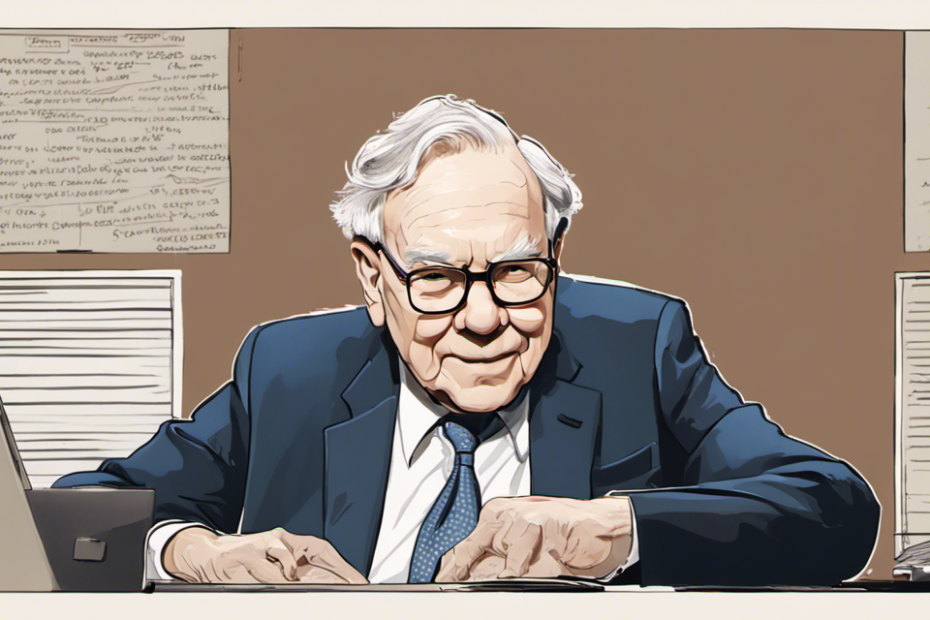Introduction
Meet Warren Buffett, a name that has become synonymous with successful stock investing. Over the course of more than six decades, Buffett has consistently outperformed the stock market, making him one of the most respected and followed investors in the world. His investment philosophy, inspired by the Benjamin Graham school of value investing, focuses on identifying and investing in securities that are unjustifiably low priced considering their intrinsic worth.
Understanding Buffett’s Investment Philosophy
Buffett’s Investment Strategy is based on the concept of value investing. He looks for companies with solid fundamentals, strong earnings power, and the potential for sustained growth. Rather than being swayed by market trends, he chooses to invest in undervalued stocks of companies that exhibit favorable economic characteristics.
When it comes to investment, Buffett’s approach is long-term. He is known for his patience and discipline, holding onto his investments for long periods, often decades, to realize their full potential. A crucial aspect of his strategy is the prioritization of a margin of safety in his investment decisions, mitigating risks and ensuring returns.
Noteworthy Investments
Warren Buffett’s success is not just theoretical; it is evident in the noteworthy investments he has made. His portfolio, built over years of diligent and strategic investment, is testament to his astute understanding of the market and his unwavering adherence to his philosophy.
As we delve deeper into the specifics of Buffett’s investment strategies, it’s interesting to compare and contrast his approach with other successful investors. For instance, a look at Prem Watsa’s investment philosophy reveals a different approach, providing a balanced perspective to our understanding of investment strategies.
Understanding Buffett’s philosophy and strategy could be a stepping stone for both novice and experienced investors in their journey of stock market investment. Stay tuned as we unravel the secrets of Warren Buffett’s investment success.
Buffett’s Investment Strategy
Warren Buffett, renowned as the “Oracle of Omaha,” has a unique investment philosophy that has guided him to immense success. His approach, grounded in the principles of value investing, has delivered substantial returns for Berkshire Hathaway and its shareholders.
Value Investing: The Core of Buffett’s Strategy
Value investing is a cornerstone of Buffett’s investment strategy. This approach involves identifying and purchasing shares of companies that appear undervalued by the market but have strong potential for growth. Buffett seeks out these hidden gems, investing in them when their price offers a margin of safety, a principle he holds in high regard.
In the landscape of the stock market, Buffett focuses on traditional industries, steering clear from high-risk sectors. His strategy is not about making quick profits from short-term market fluctuations. Instead, it revolves around making long-term investments and patiently waiting for the market to recognize a company’s true value.
Durable Competitive Advantage: Buffett’s Golden Rule
Warren Buffett is particularly interested in companies with a durable competitive advantage. Such an advantage could come from a strong brand reputation, superior products or services, or high barriers to entry for competitors. This competitive edge often leads to sustainable earnings, a factor Buffett meticulously considers when selecting investments.
For instance, Buffett’s noteworthy investments in larger corporations like Amazon, Taiwan Semiconductor, and Apple, despite being a departure from his earlier preferences, still reflect his core principles. These companies have dominant positions in their respective markets, providing them with a durable competitive advantage.
Return on Equity and Profit Margins: Key Metrics in Buffett’s Analysis
When evaluating potential companies for investment, Buffett pays close attention to return on equity and profit margins. These metrics help him gauge a company’s ability to generate earnings, a critical factor in his decision-making process.
Buffett believes that a high return on equity and healthy profit margins often signal a company’s strong financial health and potential for growth. This aligns with his value investing approach, as these metrics can indicate whether a company is undervalued relative to its intrinsic worth.
A Snapshot of Buffett’s Key Investment Principles
| Key Principle | Description |
|---|---|
| Value Investing | Purchasing shares of undervalued companies with strong growth potential |
| Margin of Safety | Investing at a price that provides financial protection against adverse future outcomes |
| Durable Competitive Advantage | Focusing on companies with a strong brand, superior products/services, or high barriers to entry for competitors |
| Long-term Investment Approach | Holding onto investments for years or even decades |
To further understand how these principles translate into practice, you can delve into the ‘buy and hold’ strategy, a key part of Buffett’s investment approach (buy and hold: a time-tested strategy). By embodying these principles, Warren Buffett has carved out a successful investment journey, one that many aspiring investors strive to emulate.
Buffett’s Noteworthy Investments
Warren Buffett, the Oracle of Omaha, has been a pillar of the investment world for decades. His investment philosophy, rooted in value investing, has led him to make some very lucrative investment choices. Let’s delve into some of his most successful investments.
Coca-Cola: A Refreshing Success
In 1988, Buffett decided to invest in Coca-Cola. With their strong market presence, consistent profitability, and a global brand that’s virtually synonymous with soft drinks, Coca-Cola showed potential for long-term growth. The decision paid off – today, Berkshire Hathaway owns approximately 400 million shares, making it one of the company’s largest shareholders.
American Express: The Power of Brand
American Express, another noteworthy investment, caught Buffett’s attention due to its strong brand and robust customer loyalty. Buffett saw the potential in the company and invested heavily in 1963. This investment has grown exponentially, demonstrating the effectiveness of Buffett’s Investment Strategy.
Bank of America: Betting on the Banking Sector
During the 2008 financial crisis, many investors were avoiding banking stocks like the plague. However, Buffett, with his keen eye for value investing, saw opportunity. He invested $5 billion in Bank of America, which has since multiplied several times over.
See’s Candies and GEICO: The Art of Understanding Business
See’s Candies and GEICO are prime examples of Buffett’s understanding of business fundamentals and durable competitive advantage. See’s Candies, with its strong brand, consistent cash flow, and solid customer base, has generated impressive returns since Buffett’s investment in 1972. Similarly, GEICO’s cost advantage and efficient business model attracted Buffett, leading to a highly successful investment.
Here’s a brief overview of Warren Buffett’s noteworthy investments:
| Company | Year Invested | Return on Investment |
|---|---|---|
| Coca-Cola | 1988 | 16x |
| American Express | 1963 | 200x |
| Bank of America | 2008 | 6x |
| See’s Candies | 1972 | 8000% |
| GEICO | 1996 | 52x |
Each of these companies, handpicked by Buffett, demonstrates the core principles of his investment philosophy – a strong understanding of the business, a durable competitive advantage, and potential for long-term growth. These Noteworthy Investments stand as testament to Buffett’s investment prowess and the effectiveness of value investing. It’s clear that by adhering to these principles, investors can improve their investment strategies, manage risk effectively, and increase their chances of achieving long-term success.
FAQs
Warren Buffett’s Advice for New Investors
Warren Buffett, the Oracle of Omaha, offers timeless advice for new investors. His first rule? Never lose money. By this, he doesn’t mean to avoid losses completely – that’s impossible. Rather, he emphasizes the importance of protecting capital and steering clear of investments that could result in significant losses. He advises beginners to start investing early and maintain a long-term perspective. This strategy allows investments to recover from market downturns and uncertainty. Lastly, he recommends patience, urging investors to wait for the right opportunities instead of rushing into every potential investment (Understanding the influence of Charlie Munger on Warren Buffett’s investment philosophy).
Common Misconceptions about Buffett’s Investment Strategy
Contrary to popular belief, Warren Buffett’s investment philosophy isn’t solely about traditional value investing or relying purely on financial metrics. While he places high importance on value, he has also invested in technology giants like Apple and Amazon in recent times. His investment decisions are deeply rooted in understanding the underlying business and its long-term viability. Critics may argue his approach is conservative and misses out on high-growth opportunities, but Buffett’s focus on risk management and preference for sustainable competitive advantages remain consistent with his long-term philosophy.
Applying Buffett’s Investment Philosophy
You might wonder how to apply Warren Buffett’s investment strategy to your own portfolio. Here’s a roadmap to get you started:
- Margin of Safety: Aim to purchase stocks at a price lower than their intrinsic value. This approach provides a safety net during market fluctuations.
- Long-Term Investments: Like Buffett, consider investing for the long haul. Avoid frequent trading and focus on quality companies with sustainable competitive advantages.
- Invest in What You Understand: Stick to businesses and sectors you’re familiar with. This understanding helps mitigate risks and allows for a better assessment of a company’s future prospects.
- Value Investing: Follow Buffett’s lead by identifying undervalued stocks with favorable economic characteristics.
- Avoid Speculation and Market Timing: Don’t try to predict short-term market movements. Instead, keep your eyes on the long-term potential of your investments.
- Diversification: Though Buffett often holds concentrated portfolios, average investors may benefit from diversifying their holdings across different sectors and asset classes.
Remember, while these principles are integral to Buffett’s investment philosophy, it’s crucial to adapt them based on your risk tolerance, financial goals, and investment horizon.
Conclusion
In the labyrinth of stock investment, Warren Buffett’s investment philosophy serves as a guiding star, illuminating the path to potential success. This philosophy, deeply rooted in value investing, has been a cornerstone of Buffett’s Investment Strategy, producing numerous Noteworthy Investments.
Buffett, the oracle of Omaha, has always emphasized on the importance of understanding the business behind the stock. As investors, it’s crucial to not just chase trends but to believe in the inherent value of a company and its potential for long-term growth.
The world of investment can often feel like a roller-coaster ride, full of highs and lows. But, as Buffett’s philosophy suggests, it’s not about timing the market; it’s about time in the market. By focusing on companies with a durable competitive advantage, investors can potentially weather market storms and emerge stronger.
At the end of the day, investing is as much about patience and perseverance as it is about finding the right opportunities. So, let’s take a leaf out of Warren Buffett’s book, and remember, “The stock market is a device for transferring money from the impatient to the patient”.
my vision is To create a community of informed and empowered investors who, armed with robust knowledge and strategies, can make prudent and profitable investment decisions.

